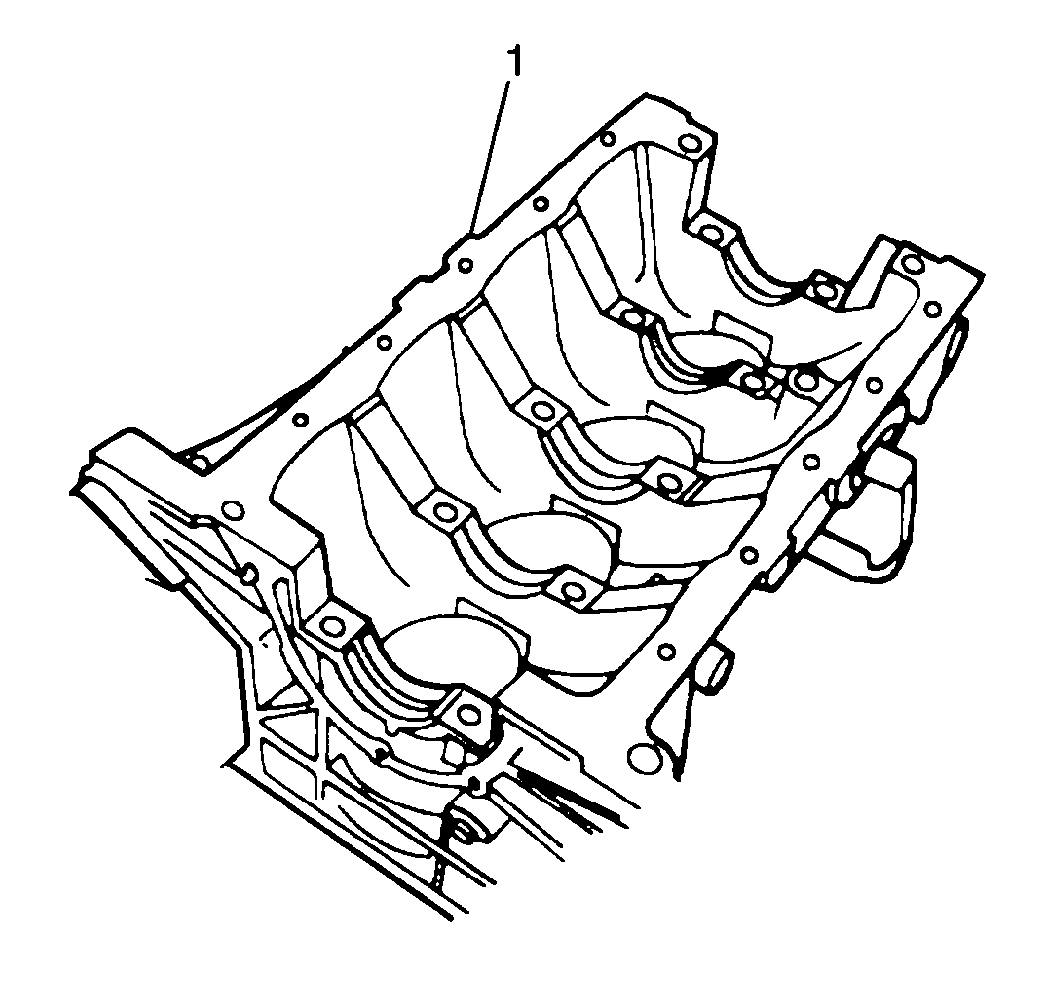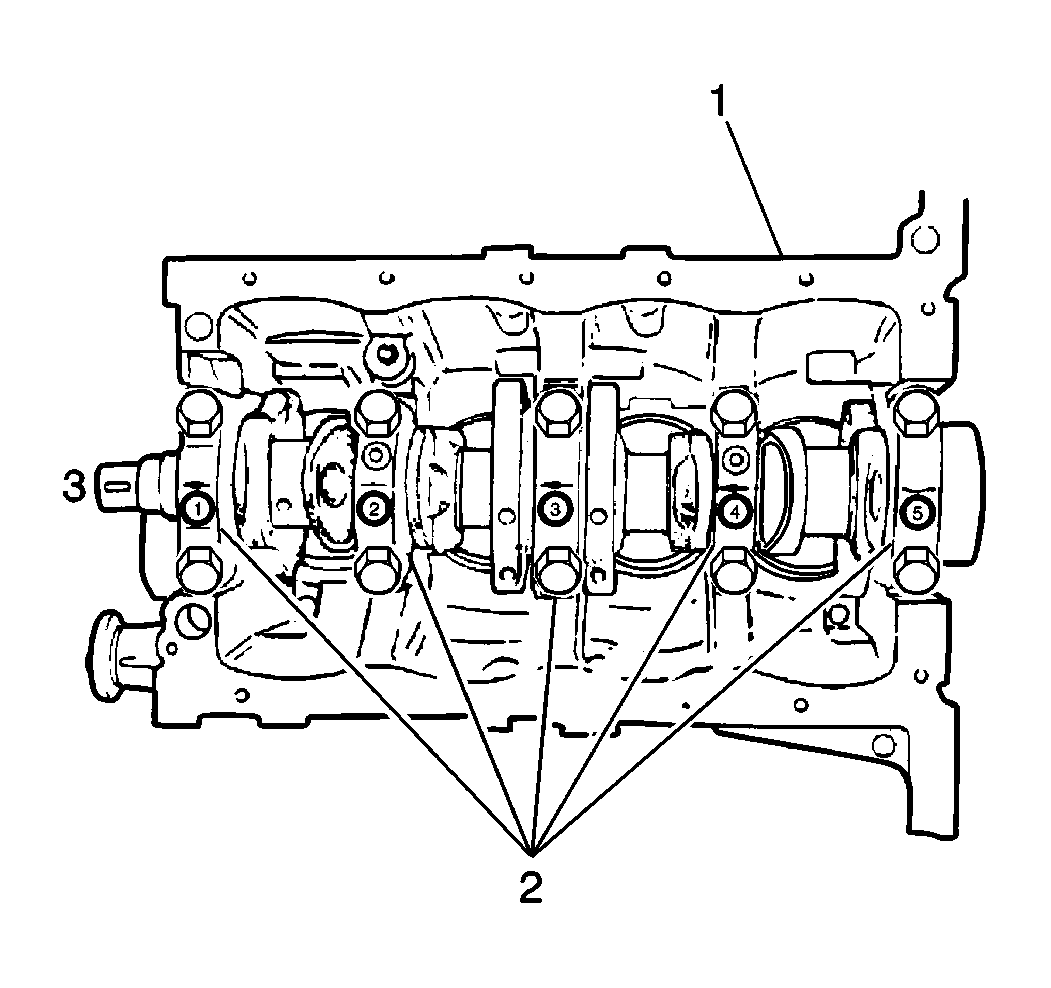Removal Procedure
- Disconnect the negative battery cable.
- Raise and correctly support the vehicle. Refer to Lifting and Jacking the Vehicle in General Information.
- Place a drain pan or a suitable container underneath the engine oil pan.
- Remove the engine oil drain plug and the gasket. Allow the engine oil to drain.
- Remove the front pipe assembly. Refer to Front Pipe Replacement in Engine Exhaust.
- Remove the two bolts and the flywheel inspection cover.
- Remove the following components from the vehicle:
- Remove the following components from the vehicle:
- Remove the 5 upper inserts from the cylinder block (1).
Caution: Unless directed otherwise, the ignition and start switch must be in the OFF or LOCK position, and all electrical loads must be OFF before servicing any electrical component. Disconnect the negative battery cable to prevent an electrical spark should a tool or equipment come in contact with an exposed electrical terminal. Failure to follow these precautions may result in personal injury and/or damage to the vehicle or its components.


| • | 16 bolts |
| • | The Crankshaft Sensor (6) |
| • | 2 nuts |
| • | The engine oil pan (1) |
| • | The Oil Pump Strainer (2) |
| • | 10 main bearing bolts |
| • | 5 main bearing caps with lower inserts |

Installation Procedure
- Install the upper inserts to the cylinder block (1).
- Install the five main bearing caps (2) with the lower inserts. Secure the caps with the ten main bearing cap bolts in the order of 1, 2, 3, 4, and 5.
- If equipped with air conditioning, install the air condition belt, and tighten the belt.
- Adjust the air conditioning belt tension. Refer to Drive Belt Replacement .
- Install the right-side splash shield, and secure the splash shield with six clips.
- Install the belt for the generator and for the cooling pump.
- Adjust the tension on the belt for the generator and for the cooling pump.
- Install the oil pump strainer and the oil pump strainer seal to the cylinder block.First, secure the oil pump strainer bolt.Then secure the bracket bolt for the oil pump strainer.
- Apply a continuous bead of GM P/N 12346240, or of an equivalent, to the mating surface of the engine oil pan.
- Install the engine oil pan to the cylinder block.Secure the engine oil pan with 16 bolts and with 2 nuts, starting at the center and working outward.
- Install the gasket and the drain plug for the engine oil pan.
- Install a new seal to the front pipe assembly.
- Install the front pipe assembly with a new seal to the exhaust manifold. Secure the front pipe assembly with 2 bolts. Do not tighten completely.
- Install the new gasket to the resonator assembly.
- Install the new resonator to the front pipe assembly, and secure the resonator with 2 nuts.
- Install the front pipe assembly to the vehicle, and support the catalytic converter with a hanger.
- Connect the oxygen sensor electrical connector.
- Lower the vehicle.
- Fill the engine oil to specifications. Refer to Approximate Fluid Capacities in Maintenance and Lubrication.
- Connect the negative battery cable.
- Inspect the coolant system for leaks.
- Start the engine. Inspect the exhaust system for exhaust leaks.
- Run the engine in order to inspect the engine oil pressure.

Important: The upper insert has an engine oil groove. Install the components with the engine oil groove to the cylinder.

Notice: Use the correct fastener in the correct location. Replacement fasteners must be the correct part number for that application. Fasteners requiring replacement or fasteners requiring the use of thread locking compound or sealant are identified in the service procedure. Do not use paints, lubricants, or corrosion inhibitors on fasteners or fastener joint surfaces unless specified. These coatings affect fastener torque and joint clamping force and may damage the fastener. Use the correct tightening sequence and specifications when installing fasteners in order to avoid damage to parts and systems.
Important: Tighten the main bearing bolts gradually and uniformly. After you tighten the main bearing cap bolts, inspect the bolts in order to check that the crankshaft rolls smoothly when turned by hand.
Each main bearing cap is embossed with an arrow mark and with a number. When installing each bearing cap to the cylinder block, point the arrow mark toward the crankshaft timing pulley side.
Tighten
Tighten the main bearing cap bolts to 54 N·m (40 lb ft).
Tighten
First, tighten the oil pump strainer bolt.Then tighten the bracket bolt
for the oil pump strainer to 11 N·m (97 lb in).
Tighten
Tighten the engine oil pan bolts and the nuts to 11 N·m
(97 lb in).
Tighten
Tighten the engine oil drain plug to 35 N·m (26 lb ft).
Tighten
| • | Tighten the exhaust manifold to front pipe assembly bolts to 50 N·m (37 lb ft). |
| • | Tighten the resonator assembly nuts to 35 N·m (26 lb ft). |
